New Chromatography Columns and Accessories for 2017
LCGC North America
Our annual review of new liquid chromatography (LC) columns and accessories introduced at Pittcon and throughout the previous year.
Our annual review of new liquid chromatography (LC) columns and accessories introduced at Pittcon and throughout the previous year.
In accordance with recent tradition, this article is intended to cover chromatography columns and accessories commercially released after Pittcon 2016 through this year’s conference held in Chicago March 5–9, 2017. LCGC once again sent out a survey in early 2017 asking vendors to supply them with any products launched after Pittcon 2016. Instrumentation is covered in this issue of LCGC (1), and gas chromatography and sample preparation will be covered in the May issue. Because information for this installment of “Column Watch” is obtained sporadically over the course of many months, it is very possible that some information has been missed. Readers are encouraged to check with specific vendor sites for additional products as well as more detailed information regarding what is covered here.
The vendors that responded to the survey with high performance liquid chromatography (HPLC) and ultrahigh-pressure liquid chromatography (UHPLC) columns and accessories are listed in Table I. The list contains very well-known vendors such as Waters and Agilent Technologies, but also several lesser-known vendors. The product range is also highly varied from traditional reversed-phase columns using fully porous materials to specialty columns. As in years past, with such a varied list, further discussion requires some breakdown of the different offerings. Similar to 2016, one differentiation can be made based on offerings that target small or large molecules. Within the small-molecule realm three subcategories could be established: reversed-phase, hydrophilic interaction liquid chromatography (HILIC), and chiral offerings. Each of these will be discussed separately. For large-molecule products, subareas involving reversed-phase mode and size-exclusion chromatography are identified and discussed. Columns commercialized using ion-exchange chromatography for both small and large molecules will be discussed separately. Furthermore, there were products launched for supercritical fluid chromatography (SFC) that deserve some discussion. An interesting and potentially game-changing microchip chromatography device based on pillar array technology is also featured. Lastly, several accessories relating to HPLC are noted.
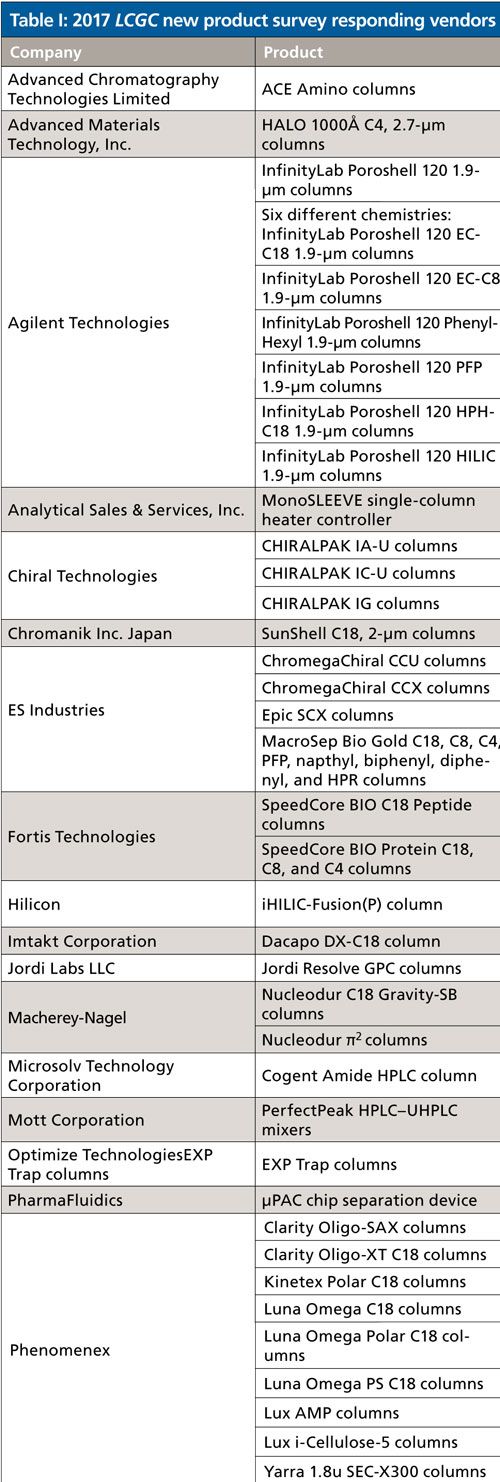
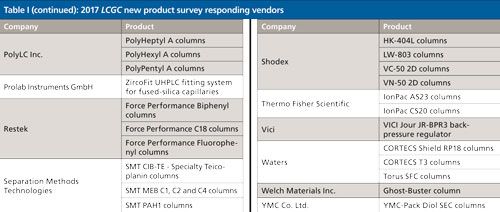
Small-Molecule Separations
Reversed-Phase Chromatography
The product offerings assigned to the small-molecule, reversed-phase category are listed in Table II. A total of 22 new surface chemistries are noted from the list. Continuing recent trends, many of the new columns are intended to round out selectivity or particle size offerings within existing lines. Of the 22 columns listed, nine are manufactured using superficially porous particles (SPP), indicating that the particle architecture continues to garner attention. Enhancements of fully porous particles (FPP) are also noteworthy. For example, Phenomenex’s Luna Omega phase reportedly includes a thermal modification that provides improved performance, inertness, and robustness as compared to conventional FPP products. Another theme consistent with 2016 is the continuing effort to increase column stability for wider pH range utility. Agilent Technologies (HPH-C18), ChromaNik Technologies (SunShell C18), and Imtakt Corporation (DZ-C18) all launched phases with enhanced pH stability. Separation Methods Technologies commercialized an interesting set of short-chain reversed-phase chemistries (C1, C2, and C4). The company contends that their proprietary bonding strategy provides “proper deactivation” of silanols as well as resistance to acid hydrolysis that plagues many short-chain surface chemistries. Another interesting trend from this year’s offerings is the presence of several “polar C18” chemistries. Phenomenex launched a polar C18 stationary phase in both the Kinetex and Luna Omega lines and Waters added its T3 chemistry to the Cortecs brand. In each case the surface modification is noted to impart a balanced retention for hydrophilic and hydrophobic molecules. Phenomenex also came out with a chemistry denoted as PS C18 which is reported to include a positively charged modification to the surface that aids in the retention of acidic analytes. More complete, full line offerings were launched by Agilent (InfinityLab Poroshell) and Restek (Force Performance).
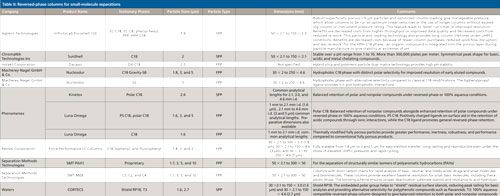
CLICK TABLE TO ENLARGE
Hydrophilic Interaction Chromatography
HILIC, which is often employed for the retention and separation of very polar compounds, continues to show growth. Table III lists product offerings in the HILIC category. The seven new entries in this category match the number of new columns reported in 2016. It is interesting to note that three of the seven entries are built on polymeric phases. HILICON introduced a polymeric version in its iHILIC-Fusion line. Shodex commercialized two polymerically based HILIC phases. The VN-50 2D diol phase is designed for oligosaccharide analysis, and the VC-50 2D carboxyl chemistry is reportedly applicable to monoamine type neurotransmitters and oral anti-diabetic drugs. The company also notes that the PEEK housing reduces undesired interactions with the column hardware. MicroSolv Technology continues to fill out its line of silica hydride based phases with a new amide chemistry. Fully porous– and superficially porous–based HILIC phases continue to be promoted. Advanced Chromatography Technologies added an amino chemistry to its FPP ACE offering, and both Agilent Technologies (bare silica) and ChromaNik Technologies (amide) added to their respective SPP lines.

CLICK TABLE TO ENLARGE
Chiral Chromatography
Eight new chiral phases were introduced after Pittcon 2016. This number is a significant increase over the same time period from Pittcon 2015 through the “New Chromatography Columns and Accessories for 2016” column installment where only three entries were noted (2). Cellulose- and amylose-based chiral phases dominate the list provided in Table IV. Chiral Technologies extended its line of meta-immobilized 5-µm phases through the introduction of Chiralpak IG. The company also introduced amylosic and cellulosic phases on 2-µm FPP particles designed for UHPLC. ES Industries continued to fill out its ChromegaChiral line with two new chemical modifications of amylose that provide what the company refers to as unique enantiomeric separation behavior. Phenomenex introduced an immobilized cellulosic phase, Lux i-Cellulose-5, which is designed to be more robust for strong organic solvents than coated polysaccharide phases. The company also launched the Lux-AMP phase. The proprietary chemistry is specifically designed for the enantiomeric separation of amphetamine and methamphetamine. Separation Methods Technologies reported the development of a teicoplanin-based chiral stationary phase. The company reports that the column is useful for performing a wide variety of chiral separations with amino acids, carboxylic acids and neutral compounds. Like 2016, it is clear from these new product introductions that amylose and cellulose phases based on FPP particles continue to dominate the field. New this year is the introduction of sub-2-µm chiral columns (Chiral Technologies); however, SPP technologies have still not entered this realm.

CLICK TABLE TO ENLARGE
Large-Molecule Separations
The separation of large molecules such as peptides, proteins, and oligonucleotides often requires larger pore sizes than are typically used in small molecule applications. Full characterization of these complex molecules often requires multiple modes of separation, including reversed-phase chromatography, size-exclusion chromatography (SEC), ion-exchange chromatography, and hydrophobic interaction chromatography (HIC).
Reversed-Phase Chromatography
In last year’s report, columns intended for reversed-phase analysis of large molecules was dominated by chemical modification of SPP particles. That trend continues this year. However, a new line of columns from ES Industries (MacroSep BIO-Gold) demonstrates that new lines based on fully porous particles are still being developed. New columns intended for reversed-phase chromatography of biomolecules are presented in Table V. Also included in the table is a new set of offerings from PolyLC, Inc. for HIC.

CLICK TABLE TO ENLARGE
Advanced Materials Technologies introduced a 1000-Å C4 column intended for very large molecules such as monoclonal antibodies (mAbs). The larger pore size as compared to many “large-molecule” columns (typically 160–400 Å) provides less restriction into the pores and thus can provide higher resolution of minor variants of mAbs. The column is based on SPP technology. Fortis Technologies reports the expansion of its SPP portfolio with SpeedCore BIO Peptide (160 Å) and SpeedCore BIO Protein (300 Å) columns. Also based on wider pore SPP technology, these offerings are intended for improved separations of peptides and proteins, respectively. Oligonucleotides also fall into this category of large molecules and offer their own set of chromatographic challenges. Phenomenex recently launched Clarity Oligo-XT, an organo-silica SPP phase intended for the reversed-phase characterization and purification of synthetic oligonucleotides. The column is reported to be stable at high pH, which is often used in oligonucleotide separations.
HIC likely deserves its own category within the large-molecule realm. However, for the sake of space it is lumped in here with the reversed-phase offerings. HIC is often a valuable tool used to separate polar variants of proteins. HIC, however, traditionally uses high concentrations of nonvolatile buffers, rendering it incompatible with mass spectrometry (MS) detection. A presentation by Andrew Alpert of PolyLC, Inc., at HPLC 2016 described efforts to render HIC MS friendly (3). Using more-hydrophobic analogs of a poly(propyl aspartamide) stationary phase, Alpert demonstrated that proteins could be denatured in MS-friendly(er) mobile phases that may lead to a possible marriage of the two techniques (4). Since that time, PolyLC, Inc., has launched three versions of the polyaspartamide phases discussed at HPLC 2016 (pentyl, hexyl, and heptyl) that permit MS-compatible HIC for proteomics and quality control of biotherapeutics.
Size-Exclusion Chromatography–Gel Permeation Chromatography
SEC continues to witness resurgence largely as a result of the focus on large-molecule therapeutics. SEC resolves analytes based on molecular size and is often used as a complementary technique to reversed-phase analysis of protein. Gel permeation chromatography (GPC) uses the same process of separation by molecular size. Separation by molecular size in aqueous mobile phases is commonly referred to as SEC, whereas separation in organic solvents such as tetrahydrofuran is normally referred to as GPC. Columns used in SEC and GPC are often characterized by strict control of pore size and by inert surface chemistry. Control of the pore size dictates how molecules of various sizes can diffuse into the pores while the inertness of the surface limits secondary interactions that may interfere with molecular size separation and determination.
Table VI lists the SEC and GPC column offerings launched since Pittcon 2016. The number of new offerings is similar to those reported last year. Jordi Labs released a divinylbenzene GPC phase in both 3- and 13-µm particle sizes that promises high efficiency, high capacity, and lower back pressure. Shodex continued to expand its offering with the release of two new chemistries on polymeric supports. The HK-404L phase is intended for rapid GPC analysis, and the LW-803 product is designed for antibody and antibody aggregate separations. Smaller-particle designs continue to infiltrate the SEC–GPC market in an attempt to enhance resolution and speed. Phenomenex extended its line of sub-2-µm SEC columns with the release of the Yarra 1.8µ SEC-X300 column. The column’s 300-Å pore size is intended for the characterization of mAb aggregates, antibody–drug conjugates (ADCs) and biosimilars with a separation range of 10–700 kDa. Similarly, YMC Co. Ltd. launched a 2-µm diol phase that reportedly exhibits greater resolution than standard 3- and 5-µm materials.

CLICK TABLE TO ENLARGE
Ion-Exchange Chromatography
Ion-exchange chromatography is a separation technique that exploits strong interactions between opposite charges of a surface and an analyte. Various surface supports may be modified to carry permanent (strong cation and anion exchange) or variable (weak cation and anion exchange) charge that can be used to interact with and separate analytes with the opposite charge. As with SEC, ion-exchange chromatography is often used as a complementary tool for the analysis of large molecules. As shown in Table VII, however, the product launches this year are dominated by columns intended for small-molecule analysis. ES Industries released the Epic SCX column, which the company claims provides superior cation loading and stability that results from a high density bonding technology. Thermo Fisher Scientific also released two new chemistries in its IonPac line. According to the company, the AS23 phase provides advanced capabilities to detect oxyhalides among other inorganic anions in various water matrices of interest and the CS20 product provides enhanced performance for the analysis of inorganic cations and amines. The lone “large-molecule” ion-exchange product release came from Phenomenex. The Clarity Oligo-SAX phase is interestingly built on a nonporous, 5-µm particle and is intended for the high-resolution analysis of synthetic oligonucleotides.

CLICK TABLE TO ENLARGE
Supercritical Fluid Chromatography
SFC continues to receive interest because of improvements in instrument design, the desire to perform greener separations, and the high resolution and speed the technique often provides. The lone line of new SFC phases reported since Pittcon 2016 comes from Waters Corporation. Several surface modifications, including 2-picolamine, diethylamine, diol, and 1-aminoanthracene built on Water’s bridged ethyl hybrid (BEH) particle technology were released under the brand name Torus. The company claims that the particle is designed especially for SFC and is enhanced by a two-stage bonding process that provides stable retention and unique selectivity.
Pillar-Array Separation Device
An interesting and potentially game-changing separation device was featured at Pittcon 2017. PharmaFluidics launched the first microchip chromatography device that is manufactured using lithographic techniques. The device features a perfectly ordered backbone that is formed by etching interstitial volume out of a silicon wafer. The company reports that the device produces highly reliable and robust reversed-phase, nano-LC separations with unprecedented peak capacity. It is certainly possible that this development may provide a revolutionary advance for liquid chromatography.
Liquid Chromatography Accessories
Although most of the attention in this series of column installments goes to the development of new columns, accessories play a vital role in enabling liquid separations. Table VIII lists several LC-related accessories that have been recently developed. Analytical Sales and Service, Inc., reported the release of the MonoSLEEVE column heater device, which features advanced “plug-and-play” technology. Mott Corporation launched HPLC–UHPLC static mixers intended to supply better sensitivity by greatly reducing baseline noise and improving lower limits of detection. According to the company, the mixers are easy to install, are pressure rated up to 20,000 psi, and can maintain high efficiency over a wide range of flow rates. Optimize Technologies released a series of trap columns under the brand name EXP. On-line trapping facilitates automation for high-throughput analysis and can be used for multidimensional chromatography processes. High-pressure capillary connections often frustrate the practitioner. Prolab Instruments has developed a novel capillary fittings system called Zircofit that is designed to allow users to assemble connections within minutes. The company reports the achievement of 20,000-psi pressure ratings with this design. VICI AG International launched a new back-pressure regulator, JR-BPR3, which reportedly extends the application range of the company’s existing line. The company claims the new regulator is manually adjustable between 90 bar and 300 bar and can be mounted into any column oven that maintains temperatures up to 80 °C. Lastly, ghost peaks in gradient LC can not only be a nuisance, but may also interfere with detection and quantitation of target analytes. The source of ghost peaks is often impurities in solvents used in mobile phases. Welch Materials has developed what it calls the Ghost-Buster column to help alleviate the issue. The column, packed with proprietary material, is installed between the gradient mixer and the sample injector and is intended to remove contaminants from the mobile phase and thus reduce or eliminate undesired responses in gradient analyses.
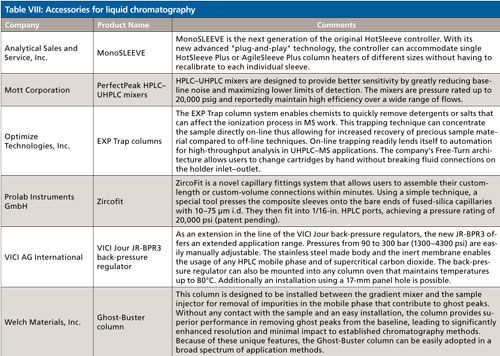
Conclusions
Overall, the products released over the past year represent evolutionary developments. The greatest number of new columns falls into the category of line extensions or “gap-filling” new product lines for individual companies based on existing accepted technologies. New known chemical modifications of both SPPs and FPPs of various particle sizes continue to be developed, and these modern particles continue to find utility in niche separation modes such as HILIC and chiral. Several reported treatments of FPP surfaces may lead to more revolutionary products, and several new chemistries, especially hydrophobic-hydrophilic balanced phases, may offer unique and powerful selectivities.
As opposed to last year, there seems to be less emphasis on large-molecule separations in terms of the number of phases that have been launched. That said, several developments in large-molecule separations could play a key role in the future of HPLC. An emphasis on even larger-pore-size particles may, for example, enable improved analysis of mAbs and other biotherapeutics. Techniques complementary to reversed-phase chromatography such as SEC–GPC and ion-exchange chromatography continue to grow at a steady pace. It is noteworthy, however, that no affinity chromatography columns were reported to be released over the past year. Is it possible that the emphasis on large-molecule separations is slowing?
The commercialization of pillar-array nano-LC devices may be the most revolutionary development over the past year. It will be interesting to see if the device leads us to more widespread acceptance of chip-based separations.
Acknowledgment
Product reviews would not be possible without the contributions and cooperation of the manufacturers that have responded to the LCGC survey. Their effort is greatly appreciated. Although LCGC has made every attempt to include every submission in the series of review articles, it is possible that some have been missed. If there have been omissions or if you want to be sure to be included in the 2018 review series, please contact Laura Bush, Editorial Director, LCGC North America, at laura.bush@ubm.com.
References
- M.W. Dong, LCGC North Am. 35(4), 246–257 (2017).
- A. Alpert, “A Series of New Materials for Direct HIC-MS Analysis of Proteins in Top-Down Proteomics,” presented at the 44th International Symposium of High performance Liquid Phase Separations and Related Techniques (HPLC 2016), San Francisco, California, 2016.
- D.S. Bell, LCGC North Am. 34(9), 700–709 (2016).
- D.S. Bell, LCGC North Am. 34(4), 242–252 (2016).

David S. Bell is senior manager of separations technologies and workflow development at MilliporeSigma (formerly Sigma-Aldrich/Supelco). With a B.S. degree from SUNY Plattsburgh and a PhD in Analytical Chemistry from The Pennsylvania State University, Dave spent the first decade of his career within the pharmaceutical industry performing analytical method development using various forms of chromatography and electrophoresis. During the past 15 years, working directly in the chromatography industry, Dave has focused his efforts on the design, development, and application of stationary phases for use in HPLC and hyphenated techniques. In his current role at MilliporeSigma, Dr. Bell’s main focus has been to research, publish, and present on the topic of molecular interactions that contribute to retention and selectivity in an array of chromatographic processes. Direct correspondence to: dave.bell@sial.com
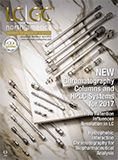
Perspectives in Hydrophobic Interaction Temperature- Responsive Liquid Chromatography (TRLC)
TRLC can obtain separations similar to those of reversed-phase LC while using only water as the mobile phase.





